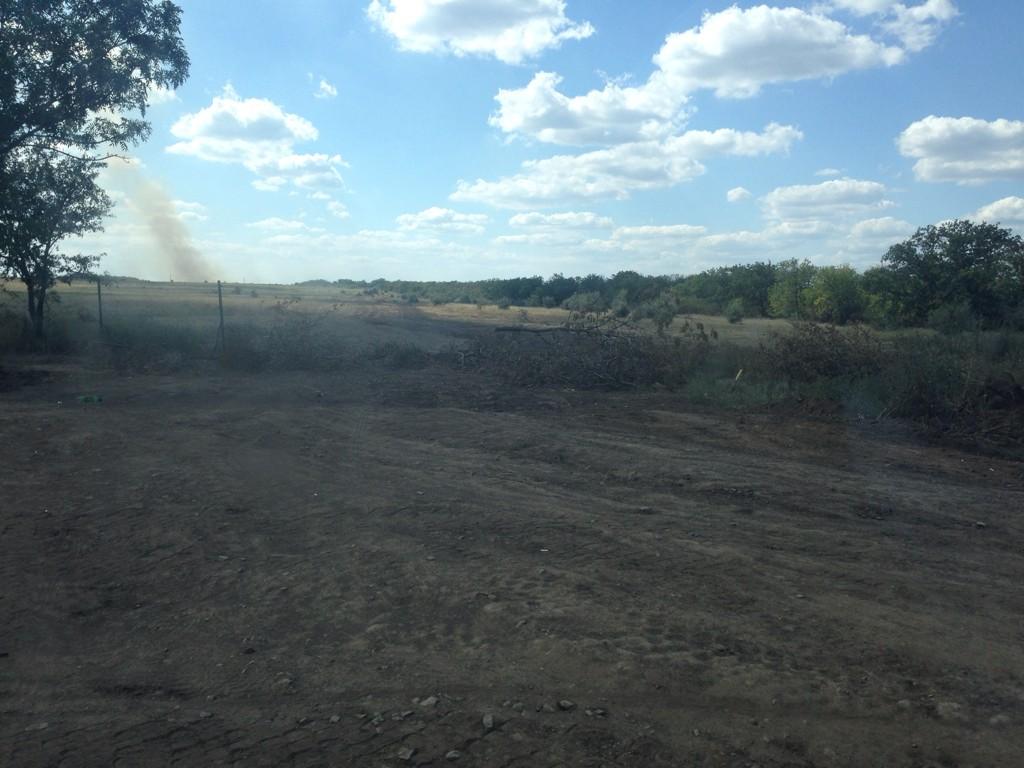Russian military vehicles drive along a road near the border with Ukraine, Rostov Region, August 17, 2014.
DONETSK, Russia — They arrive every day, carloads of young men and women in camouflage who pass through this Russian border checkpoint before heading for the battlefields of eastern Ukraine.
Although patches sewn into their uniforms identify them as separatists, their passports are routinely stamped by Russian officials. After passing by a monitoring station from the Organization for Security and Cooperation in Europe and a Ukrainian border post now operated by the separatists, they disappear into Ukraine’s civil war.
The rebel war effort may be flagging, but the Russian border in the region still controlled by the separatists remains a hive of military activity.
Almost nightly, convoys of tanks and other military vehicles can be seen on local roads, lumbering west toward Ukraine after dark, turning off dirt roads within miles of the border, apparently following routes previously favored by smugglers sneaking cheap gasoline into Ukraine.
Donetsk, August 21st 2014.
Heavy fighting on Wednesday damaged areas of Donetsk. The mayor’s office reported 43 people killed in little more than a day.

Ukrainian Troops Press Rebels in Their Eastern Strongholds August. 21, 2014.
Ukrainian Troops Press Rebels in Their Eastern Strongholds August. 21, 2014.
President Vladimir V. Putin of Russia has repeatedly denied any Russian role in backing the rebels, while insisting that what goes on within Russia’s borders is its own business.
But the activity and the overt presence of separatists in Russian border towns like Donetsk (not to be confused with the much larger Donetsk, Ukraine), which are closely watched by the Russian border guard service, are evidence that the rebels’ activities are at the very least tolerated.
The Organization for Security and Cooperation in Europe monitoring stations were established last month at the border crossings in Donetsk and Gukovo, at the behest of Mr. Putin, to allay fears about the porous border. Paul Picard, the chief observer here, said the mission regularly sees young men in camouflage clothing crossing the border, but so far none of the monitors have seen weapons or armor.
Pro-Russian rebels ride on a newly acquired Russian APC's near the town of Krasnodon, eastern Ukraine on Sunday, Aug. 19, 2014
The border between Russia and Ukraine is vast and, for long stretches, virtually unguarded, leaving ample space for surreptitious movements of weapons and vehicles that Moscow has been accused by NATO and the Ukrainian government of organizing.
So sensitive has the issue become that when two British journalists reported last week that 23 armored vehicles had crossed through a small hole in a border fence in Donetsk, the Russian security service, the F.S.B., issued a rare denial.

Patrol units have been created because of shelling near the border, the agency said, “But they act exclusively on the territory of the Russian Federation.”
The human traffic across the border has been much harder to ignore, however.
Aleksandr Zakharchenko, a rebel commander and prime minister of the self-declared Donetsk People’s Republic, said last week that 1,200 new fighters who had trained in Russia and 150 new tanks and armored vehicles had recently arrived in eastern Ukraine. He offered no evidence of such an influx, and his statement could not be independently verified.
The conflict has so far left more than 2,086 dead and 5,000 wounded, the United Nations announced recently. As the casualties have mounted, so has the traffic of wounded fighters out of Ukraine, and hundreds have been evacuated through border points like the one in Donetsk to government hospitals throughout the Rostov region.
In many hospitals, like the Central City Hospital here, rebel fighters outnumber civilians from Ukraine.
Yuri, 52 — who, like others interviewed for this article, did not want to be identified by last name as a rebel fighter — worked for almost 30 years as a rescue worker in coal mines in the Luhansk region before enlisting with the rebels.
His military career ended in early July when shrapnel from a mortar round narrowly missed his spinal cord. His left arm was amputated at the shoulder, along with his left foot. About a month ago, he was whisked across the border along with several other fighters.
“Of the second platoon, only five people are left,” he said, speaking of heavy casualties among the rebels. “From the third platoon, my platoon, maybe 10 of those who began are left.”
Ukrainian soldiers detaining a pro-Russian fighter in the village of Chornukhine. Russia is accused of sending arms and fighters across the border into Ukraine. (August 19 2014).
According to Lilia Nikolaevna, a nurse at the hospital, 10 to 20 wounded rebels are brought across the checkpoint to the hospital each day.
When 40 wounded separatist fighters arrived at the main city hospital on three buses bearing Ukrainian license plates on Sunday, officers from the Federal Security Services, hospital staff and Emergency Ministries staff were all waiting.
A dozen F.S.B. agents questioned the men before they were admitted to the hospital or transported elsewhere.
In a hospital in the city of Kamensk-Shakhtinsky, about 40 miles from the border, a 52-year-old machinist named Oleg sat in his hospital bed. His left leg had been amputated in Ukraine.
“In moments like this, yes, I feel Russia’s support,” he said, as he flicked the ash from a cigarette into an empty coffee container. All of his operations had been paid for, he said. “I understand that Putin can only help us so much, at least openly. It’s politics, after all.”

No comments:
Post a Comment